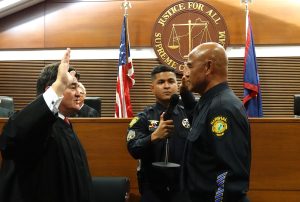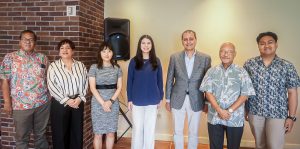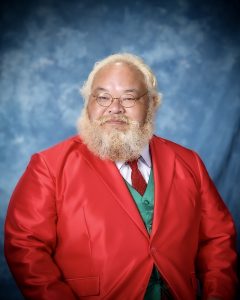Street names, language barriers confound Census 2000
The absence of street names and house numbers in the Northern Marianas has complicated gathering of population data under the Census 2000, which concludes today following three months of house-to-house visits throughout the islands for enumeration.
The presence of thousands of non-English speaking foreign workers in the Northern Marianas also confounded the enumeration process that necessitated the hiring of translators for at least four ethnic groups from Asia.
Census 2000 Area Manager Sohale Samari said enumerators who speak and understand Bangladeshi, Korean, Chinese and Japanese have been promptly and appropriately dispatched to houses whenever there was need for translation.
“We have to make sure we get accurate information from the people we interview. While language barriers may have complicated the interview, we made sure we have available ways to respond to any difficulty,” Mr. Samari told a press conference yesterday.
He said the questionnaires were also translated into Chinese, Korean and Japanese, adding that nonresidents from the Philippines were not as much a problem since they are very much familiar with the English language.
According to Mr. Samari, the fact that CNMI is home to several thousands of foreign workers made actual collection of information a little more complicated compared with other territories where language barrier was never a concern.
The guest workers’ familiarity with the questions asked during the interview and their ability to provide direct answers have also been considered major factors in making the enumeration process slightly confounded.
At the same time, Census 2000 Washington Advisor Tasha Boone said definition of housing units in the Northern Marianas is different from its traditional description.
“There are houses here that actually shelter more than two families who are not at all related. Some of the houses even have more than one entrance, you can’t tell which one is the main door,” Ms. Boone explained.
Successful enumeration
Overall, census officials are confident everyone on the islands has been counted although they admitted that the degree of accuracy of the information collected from the interviewees may not absolute.
Mr. Samari said gathering of information for this year’s census was able to solicit great support from and strong participation of all ethnic groups in the Northern Marianas, noting that none of the enumerators who went house-to-house had been refused for interview.
Both Mr. Samari and Ms. Boone are confident their work will receive approval by the Task Force that will be created by Gov. Pedro P. Tenorio to review final results of enumeration, clean-up and coding process.
Census 2000 now enters into the clean-up and field follow-up phase wherein some field workers will once again be deployed to several areas to get samples in order to determine the accuracy of initial information collected during the enumeration process.
“We would be checking under this process if the housing units that were initially reported as vacant are actually vacant or whether we have really counted all units throughout the islands,” Mr. Samari said.
Ms. Boone also said the clean-up and field follow-up stage would determine whether or not all questions have been answered, stressing that these are among the most important phases of the Census 2000.
She expressed optimism Census 2000 is able to establish a higher degree of accuracy regarding the collected information primarily because this is the first time enumerators from Rota and Tinian were tapped to gather data within their respective island.
“We have enumerators from Rota and Tinian collecting the population data in their respective island. This is the first time we ever did that because previously, people from Saipan are sent there to gather information,” Ms. Boone stressed.
Not even the Northern Islands was not left covered by the Census 2000, a complete accounting of every individual throughout the mainland United States and its territories held every 10 years.
Mr. Samari and some enumerators were flown by a helicopter to the inhabited portions of the Northern Islands last month to enlist every single individual residing in the area.
He disclosed Census 2000 teams did not find any family residing in Pagan and Anatahan, only shelter-type structures that appear to be temporary hermitage for fishermen in the area.
Mr. Samari disclosed, however, that they have enumerated people residing in Agrigan.
The U.S. government holds census once every 10 years to measure how much funding a public entity needs and identify better ways to efficiently respond to both natural and man-made disasters.
Census data are used by federal and local government agencies in responding to disaster and emergency calls. Census 2000 will include mapping of houses through door-to-door collection of data. The information will then be kept in the archives for use in disaster relief.
Result of the Census 2000 will also determine whether Saipan can already be classified as an urban area. Under existing laws, an area is considered urban only when its population count reach over 100,000. As of the 1990 census when population was less than 50,000 , Saipan’s classification remains rural.
More than $3.5 million has been earmarked from the U.S. Department of Commerce Fiscal Year 2000 budget to carry out the census in the Northern Marianas. The undertaking has created almost 500 jobs.






